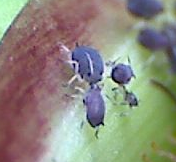Aphids- of the superfamily Aphidoidea- are insects that have caused a great level of destruction and fretting to many a gardeners efforts.
Alternatively we can view them as a highly successful, intriguing group of organisms.
An interesting aspect of aphids is that they have a great control over reproductive output. Depending on the species aphids produce partially asexually. Females produce live young that are full clones during the summer months. That’s right, young are completely identical to their mothers except for size; sharing all of her life coding DNA goodness. Following summer the drop in temperature or available food stimulates the production of sexual males and females that will mate, creating eggs to survive through winter and hatch when conditions become more tolerable.
Yet again, the process of evolution has culminated in an invertebrate male with a reduced role. Through out my studies it’s become clear that this is somewhat of a recurring theme in a variety of arthropod groups, in which the males serve little purpose but to carry sperm (and thus deposit said sperm). Take from this what you will…however there is actually a remarkable purpose.
Introducing an additional set of chromosomes, in sperm, effects the shape of the offspring produced and how they operate within a population. What is interesting is how insects manipulate the timing of male input, in order to suit specific requirements of the population. In the case of aphids this comes at a point when their energy should be invested in a form of offspring that can survive the harsher winter conditions i.e. eggs. As a result males aren’t even present in the aphid life strategy for a relatively large portion of it!
If that wasn’t enough, in the result of poor feeding conditions winged offspring will be produced that can disperse to more rich areas, an effective adaptation that makes them a potential problem to any plant in the area. Because of this and the aphids ability to quickly produce live young, populations are transient and highly mobile. It has been interesting to see this in the glasshouse: one week a plant has been infested with one species of aphid and the next week with another.
At the moment there is a black species and a green species of aphid present in the display. There numbers are not very high and I’ve found many dead from natural fungal diseases so control measures shouldn’t be necessary for now.



Great stuff Sam. I’m pleased to see nature controlling the problem and I must say i’ve been surprised at the level of natural predation/control through parasites and fungi.
The baby aphids are nearly always born gestating the next generation as well, they reproduce like pro’s.